
Protect your soil from compaction
What is soil compaction?
Compaction occurs when a force compresses the soil and pushes air and water out of it so that it becomes more dense. Compaction is more severe when the soil is wet and less able to withstand compression.
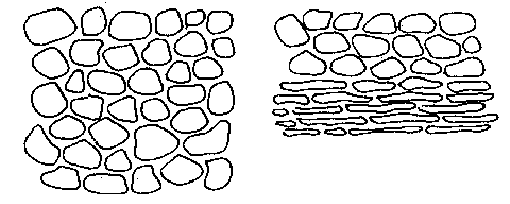
Why should I worry about it?
Compaction is a concern because it affects plant growth. There are not enough pores or spaces in compacted soil to allow unrestricted root movement, infiltration, drainage or air circulation. The restricted roots are often unable to take up sufficient water or nutrients from the soil. The result is less plant growth and lower yields, particularly during periods of drought.
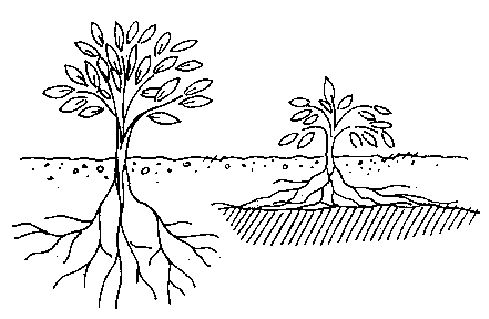
What causes soil compaction?
The most common causes of compaction on farms are animals and machinery, mostly tractors and heavy cultivation and harvesting equipment.
The degree of compaction depends on the force compressing the soil, the contact area with the soil, the strength in the soil and the type of soil. Animal hooves and tyres of light vehicles compact the soil directly underneath and around the contact area; heavy vehicles compact the soil more deeply. Tyre width has little effect, except that near-surface compaction is reduced as tyres becomes wider. The same object causes more damage to a moist soil than a dry one, particularly in clay soils.
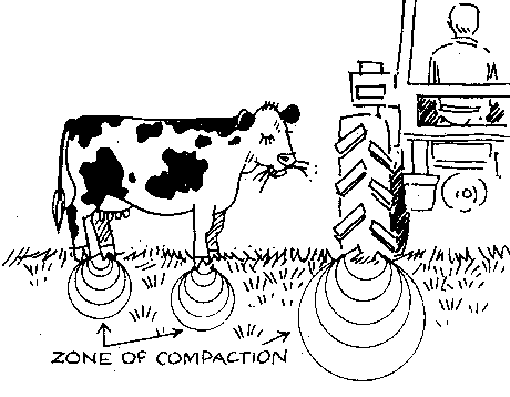
If you plough regularly to the same depth the soil compacts under the plough and forms a plough pan. Ploughing wet soil causes greater compaction than ploughing dry soil. As well, the plough smears wet soil, producing a hard, shiny surface that may reduce water and air movement.
Some soils are more prone to compaction than others, particularly soils with a lot of fine sand and silt and little organic matter. Wet clay is much more easily compacted than dry sandy soil. Some clays are more prone to compaction than others because of their high sodicity (high levels of sodium in the clay).
How can I tell if soil is compacted?
Compaction often occurs in a layer below the soil surface, so is not easy to identify on the surface. The simplest way is to push a steel rod or even a long screwdriver into the ground. If you can't push it very far your soil may be compacted or very dry.
To check further, dig a 30-cm deep hole. As you dig you will be able to feel if there is a hard, compacted layer. With your shovel, take a slice off one side of the hole, lift it out and lay it on its side. Compacted soil shows up as a hard solid layer with large, deformed aggregates. The soil above it is usually looser and separates quite easily to expose the smooth surface of the compacted section. The compacted soil is often arranged into horizontal layers, giving a platy structure. You may see plant roots growing horizontally along the top of the compacted layer because they cannot grow through it.
How can I repair compacted soil?
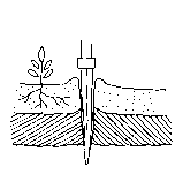
Deep tillage with tractors and implements such as an Agroplow® or a Yeomans plow® can break up compacted layers with minimal soil mixing, restoring the soil's ability to soak up and store water and allowing roots to grow. However, it is important that you do this at the right moisture content. If clay soils are too wet they will be smeared and compacted; if sandy and loamy soils are too dry they can be pulverised to dust. In cracking clays, drought-stressed rotation crops can be used to create shrinkage cracks. If enough cracks are produced, deep tillage may not be needed.
Repair compacted soil before you introduce techniques such as minimum tillage and direct drill, otherwise these techniques are unlikely to be successful.
How can I avoid compacting soil?
Try to keep wheel width to a minimum, have the same wheel spacing on all your machines, and follow the same tracks in your paddocks (tramlining). The soil under the tracks will compact severely, but this will provide good traction, and you will have minimum compaction where plants are growing.
Keep machinery and animals off wet soil. Some dairy farmers have installed feeding pads for this purpose. If you have to use a wet paddock, remember that bare soil is much more easily compacted than soil with thick ground cover. Vegetation cushions the soil on top, while the plant roots maintain soil structure underneath.
In orchards, use light machinery for routine maintenance in orchards, and plant perennial low-growing cover crops which require minimal mowing. Avoid tree spraying and slashing in wet periods as far as possible.
Test to help avoid compacting soil
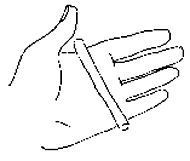
A simple test will help you avoid compacting your soil. Rapidly squeeze a small lump of soil into a ball and try to roll it into a rod about 3 mm in diameter. If you can make a rod easily, the soil is too wet and will compact if it is worked or has animals or machinery on it. If you can just make a crumbly rod the water content should allow traffic and cultivation without compaction. If you can't make a rod at all, the soil could be too dry for tillage in a sandy or loamy soil. You need to do this test at several points over the full depth of any proposed cultivation.
From the Soil Sense leaflet 1/94. Agdex 510 produced by Rebecca Lines-Kelly, formerly soils media officer, Wollongbar Agricultural Institute, for NSWA and SCS, north coast region, under the National Landcare Program, September 1994.

